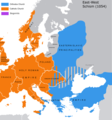Íomhá:Great Schism 1054 with former borders.png

Size of this preview: 560 × 599 picteilín. Other resolutions: 224 × 240 picteilín | 448 × 480 picteilín | 717 × 768 picteilín | 957 × 1,024 picteilín | 2,000 × 2,141 picteilín.
Taispeáin leagan ardtaifigh den íomhá (2,000 × 2,141 picteilín, méid comhaid: 420 KB, cineál MIME: image/png)
Stair chomhaid
Cliceáil ar dáta/am chun an comhad a radharc mar a bhí sé ag an am sin.
| Dáta/Am | Mionsamhail | Toisí | Úsáideoir | Nóta tráchta | |
|---|---|---|---|---|---|
| faoi láthair | 13:16, 9 Iúil 2023 |  | 2,000 × 2,141 (420 KB) | Veverve | Reverted to version as of 21:25, 11 November 2022 (UTC): this is a huge extrapolation to make based solely on the fact that there were some Byzantine churches in Hungary |
| 15:01, 19 Márta 2023 |  | 2,000 × 2,141 (439 KB) | Moodylo333 | Reverted to 8 November 2017 according with Dora Wiebenson, József Sisa, Pál Lövei, "The architecture of historic Hungary" (p. 11) who admit the presence of byzantine churches in Eastern Hungary. | |
| 21:25, 11 Samhain 2022 |  | 2,000 × 2,141 (420 KB) | Gyalu22 | As Veverve said, no personal opinions should be used. The previous status in Hungary was drawn by Cepleanu who referred to the Westermanns Atlas in the talk page. But that atlas shows the situation very differently. | |
| 19:58, 23 Deireadh Fómhair 2022 |  | 2,000 × 2,141 (479 KB) | Veverve | Reverted to version as of 11:04, 1 June 2022 (UTC) original research and personnal opinions should no be used | |
| 19:12, 23 Deireadh Fómhair 2022 |  | 2,000 × 2,141 (492 KB) | Gyalu22 | Religion was not an ethnic question. Transylvania was a religiously diverse region, but Catholicism was already dominant to Alba Iulia | |
| 11:04, 1 Meitheamh 2022 |  | 2,000 × 2,141 (479 KB) | Moodylo333 | Reliable version with Alexander Kazhdan (dir.), Oxford Dictionary of Byzantium, New York et Oxford, Oxford University Press, 1991, 1re éd., 3 tom. (ISBN 978-0-19-504652-6 et 0-19-504652-8, LCCN 90023208), 1991, art. « Patriarchates », vol. 3, pp. 1599-1600. | |
| 13:51, 1 Feabhra 2022 |  | 2,000 × 2,141 (488 KB) | Moodylo333 | Reverted to version as of 20:17, 8 July 2018 (UTC) without Bogomils (off topic) | |
| 13:49, 1 Feabhra 2022 |  | 2,000 × 2,141 (488 KB) | Moodylo333 | Reverted to version as of 20:15, 8 July 2018 (UTC) : COM:CROP | |
| 09:41, 26 Samhain 2021 |  | 2,000 × 2,141 (420 KB) | Veverve | Reverted to version as of 15:53, 26 October 2011 (UTC) revert to version closer to the Westermanns Atlas zur Weltgeschichte, see File_talk:Great_Schism_1054_with_former_borders.png#Numerous_problems,_map_is_unreliable | |
| 23:18, 29 Bealtaine 2021 |  | 2,000 × 2,141 (494 KB) | Ceha | Catholic-ortodox borders in the southeast |
Úsáid comhaid
Tá nasc chuig an gcomhad seo ar na leathanaigh seo a leanas:
Global file usage
The following other wikis use this file:
- Úsáid ar ar.wikipedia.org
- Úsáid ar ca.wikipedia.org
- Úsáid ar cs.wikipedia.org
- Úsáid ar de.wikipedia.org
- Úsáid ar de.wikibooks.org
- Úsáid ar en.wikipedia.org
- Úsáid ar fr.wikipedia.org
- Úsáid ar hu.wikipedia.org
- Úsáid ar ro.wikipedia.org
- Úsáid ar www.wikidata.org
